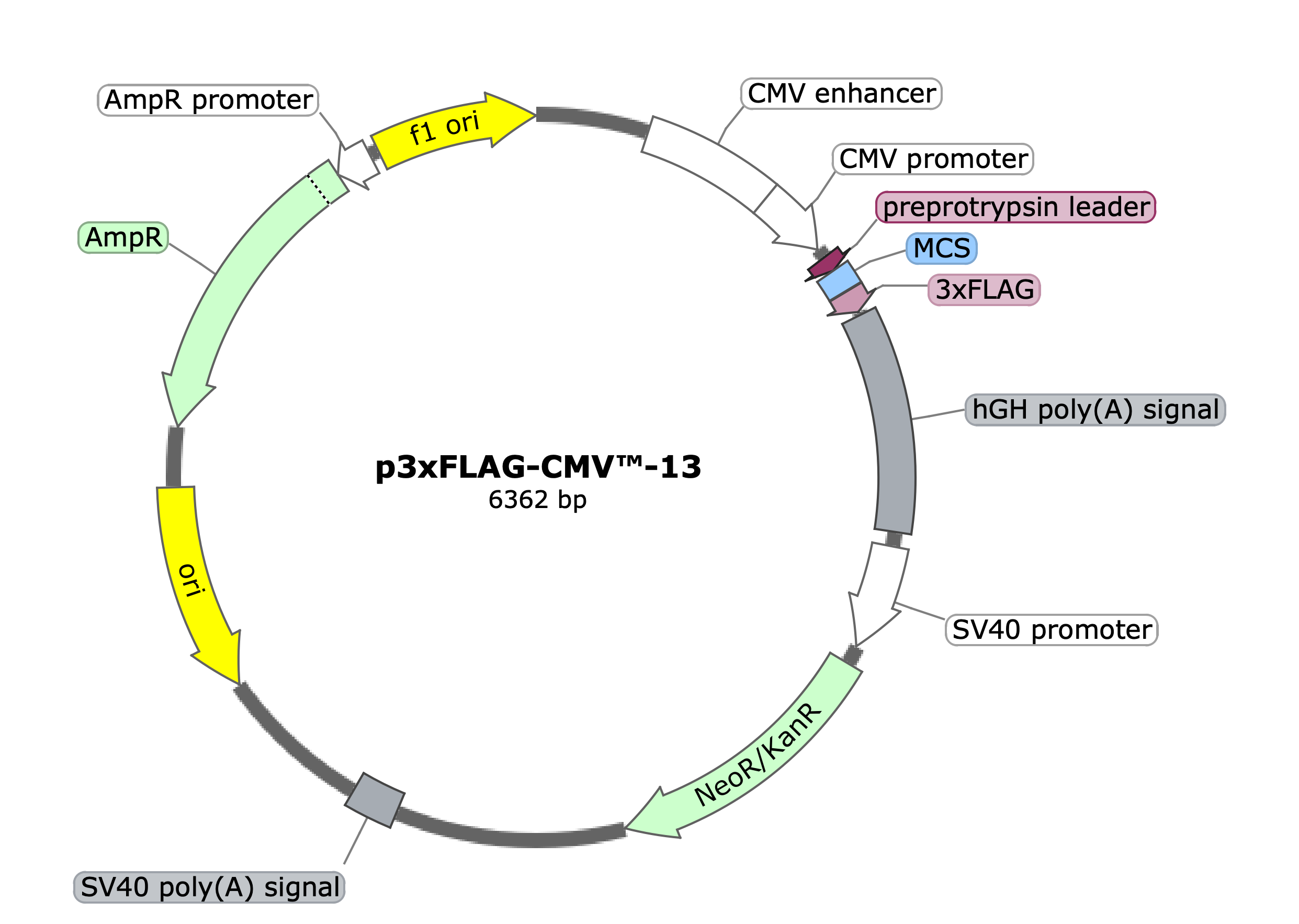Expression vectors are plasmids used to express a gene of interest in a cellular host. Selecting the right expression vector is key to the success of research and biotechnology product development projects.
Expression vectors are used for precise control of the expression of a recombinant protein used in protein production applications. They can also be used in basic research to investigate the function of the expressed protein. They make it possible to introduce the coding sequence of the protein of interest into a cellular host where the gene can be expressed.
There are two categories of expression vectors. Plasmids are circular DNA molecules that are easy to work with because they can be propagated in bacterial cells. Viral vectors are viruses engineered to “infect” a host cell with a gene of interest.
This article will focus on plasmids as expression vectors. It discusses how to select the right expression vector for various applications.
Applications for expression vectors
Expression vectors can be used in two broad categories of applications: production of recombinant proteins extracted from the expression hosts and genetic engineering of the expression hosts.
Production of recombinant proteins
Non-synthetic pharmaceuticals and drugs often come from living organisms. These products, commonly peptides and enzymes, can sometimes be harvested and purified directly from an organism that has been genetically modified to produce the protein.
Insulin is probably the most famous example of biologic drug. Initially, insulin was extracted from the pancreas of pigs and cows. However, this approach resulted in limited supplies and raised some biosafety concerns as animal products can be contaminated with viruses.
The production of recombinant insulin by Genentech in the late 70s is often regarded as the disruptive innovation that launched the biotechnology revolution. Fifty years later, the availability of mature expression vectors makes it possible for amateur scientists to engineer yeast to produce insulin for their own use.
Recombinant proteins are also used for developing diagnostics. For example, until recently the only source of an important toxin test component, LAL, was from harvesting the blue blood of horseshoe crabs. Instead of harvesting wild animals like the horseshoe crabs, researchers added the gene for crab LAL to an expression vector. The vector allows bacteria to produce LAL without catching crabs and harvesting the enzyme from their blood.

Beyond biomedical applications, new biotechnology startups are using expression vectors are used to produce new materials and more sustainable foods.
Genetically modified organisms
In other cases, expression vectors are used to express a recombinant protein with the goal of modifying the expression host.
In basic research, scientists can study how a gene impacts a cell line by controlling its expression via an expression vector. For instance, many diseases involve a gene mutation. To study the disease, researchers can use an expression vector to put the mutated version of a gene into cells and study its impact. In other cases, expression vectors can be used to make transgenic mice that have been engineered to understand the function of a gene.
Humans have been modifying genetics through selective breeding in agriculture since the dawn of civilization. In the last century, expression vector technology has vastly accelerated this field. Expression vectors allow researchers to rapidly transfer specific gene sequences that, for instance, increase drought tolerance, provide resistance to pests, or allow more efficient farming practices.
In the biomedical field, expression vectors are used in gene therapy applications aiming at providing patients with a functional version of a gene. They can also be used in cell therapy in which the patient’s cells are genetically modified to fight a disease like cancer. To accomplish this, a patient receives a therapeutic gene sequence via an expression vector, where then the patient’s cells express and use the gene.
Expression host
Each expression vector works in a specific host organism or in a family of closely related hosts. This is because expression vectors utilize cellular machinery in the host for expression. Importantly, the enzymes controlling gene expression in different types of organisms recognize different DNA sequences. Thus, a vector will only express a gene if those specific sequences are present.
The host selection is largely determined by the application of the expression vector. For example, the development of a transgenic crop will require an expression vector that works in plants. Similarly, the production of a biologic drug in a mammalian cell line requires a vector that supports mammalian expression. Likewise, the production of insulin in bacteria requires a vector supporting bacterial expression.
Elements of an expression vector
Plasmids used as expression vectors are commonly assembled and propagated in the bacteria Escherichia coli. They are also produced in bacterial cultures before being injected into the host cells where they express the target gene.

Therefore, expression vectors include two categories of genetic elements. Some elements are used for assembly and propagation in E. coli. The others are used for controlling the expression of the cloned gene in the expression host.
In order to be replicated by the bacterial cell, plasmids require a starting point called an origin of replication. Common origins of replication are ColE1 and pMB1. The choice of the origin of replication determines the plasmid abundance in the bacterial cells. A high copy number origin of replication is generally preferred as it will produce more plasmid DNA from a bacterial culture.
Bacterial cells don’t always take up plasmids, and sometimes the ones that do lose them. For this reason, plasmids contain a selection marker. This is a DNA element allowing for the selection of only cells that internalized the plasmid DNA.
The most common markers are antibiotic resistance genes. Adding the corresponding antibiotic to the bacterial culture ensures that the culture only contains cells carrying the plasmid.
Like cloning vectors, expression vectors generally include a multiple cloning site that makes it easier to insert the gene of interest using standard molecular biology techniques.
The elements involved in the control of gene expression in the host include the promoter, terminator, and various other regulatory elements.
The promoter is probably the most important genetic element involved in gene expression. A gene sequence, alone, will not be expressed. Promoters are specific DNA sequences proceeding the gene sequence which recruit the enzymes needed to initiate gene expression. Specific promoters can yield higher or lower levels of gene expression.
Some promoters can be activated by adding a drug, allowing for tight control of gene expression. Not only are promoter sequences host-specific, but they can also be tissue-specific. This can be especially helpful for controlling gene expression in GMOs. For instance, adding a PEP carboxylase promoter will only permit expression cells performing photosynthesis.
Transcription terminators and insulators are other genetic elements commonly found on expression vectors. Mammalian expression vectors generally include enhancers that remotely increase transcription from the promoter region. Introns and polyA tails are also commonly found in many modern mammalian vectors.
Getting the expression vector you need
There are two main strategies to get the expression vectors matching the requirements of a project.
Several vendors are proposing large collections of expression vectors for various applications. Users of these products can clone their gene of interest in these plasmids. Some of the most popular expression systems are provided by:
The other approach relies on gene synthesis. Most gene synthesis companies allow users to insert synthetic genes in vectors designed for standard applications.
- Twist Bioscience offers a dozen or so mammalian expression vectors that compatible with most project requirements.
- Blue Heron provides a large collection of mammalian and bacterial expression vectors includes various protein tags.
Recent Posts
Expression Vector Optimization for Protein Production
Most recombinant proteins can be produced by simply cloning the corresponding genes into standard...
Using high-throughput processes to optimize protein expression
Scientists in charge of protein expression optimization projects all too often fly by the seat of...
Kozak Sequences: what they are? how to use them? consensus sequences
The Kozak sequence is a specific nucleotide sequence in eukaryotic messenger RNA (mRNA) that plays...


